Bagore Ki Haveli Museum is one of the major attractions of Udaipur City in Rajasthan India in 2016. We visited here on our trip to Udaipur. Although, before going here, all I could imagine was, yet another museum with old artifacts and all. But, to the contrary, I found it to be so much interesting upon visiting. Bagore ki Haveli museum is divided into five major sections:
- The Puppet museum
- The main haveli
- The Turban museum
- The Weapon museum
- The Wedding Depiction Section
And each one of these is beautiful and well maintained. Apart from that, what added to the charm of visiting here was the fact that it was not at all crowded. In fact, we got to see only one or two other tourists in the whole premise. Let me take you through a walk of the museum.
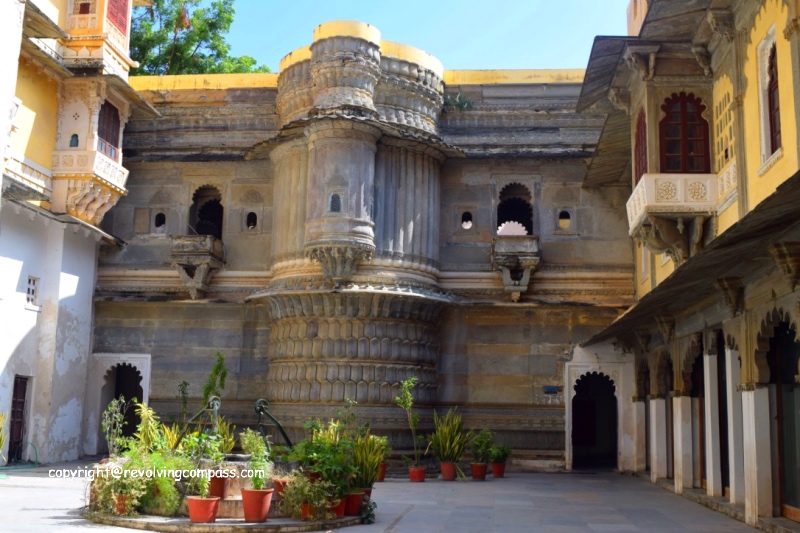
History of Bagore ki Haveli
Bagore ki Haveli was built by Shri Amarchand Badwa, who was the Prime Minister of Mewar from 1751 to 1778. The property was a part of Mewar state till independence of India in 1947. And after independence, the government started using the building for housing Government employees. However, it was a national property with not much of vested interest from any party, for almost 40 years the building was ignored and almost reached a deprecated state where it would have collapsed one day. But finally, the government was persuaded to take care of it. And thus, it was converted into a museum. We are really glad about the step taken to convert it into a museum. Now, one of the reminiscent of the glorious past of the kingdom of Mewar is secured!!
A tour through Bagore ki Haveli
As you enter inside Bagore ki Haveli Museum, there is a big open space. Crossing this space, you reach the actual building, the haveli. From here, you take a flight of stairs and reach the first floor. And there is a courtyard at the first floor. A stage is setup here for music and dance performance called Dharohar show, which happens towards the evening. But we visited here in the afternoon. So, we escaped this section and went on to the other side of the stairs, that leads to the puppet museum.
The Puppet Museum at Bagore Ki Haveli
As the name suggests this section of Bagore Ki Haveli Museum has lots of puppets on display. Puppets are an integral part of Rajasthani culture. Thus, the museum totally makes sense. I loved this section and so did my little daughter. There are different kind of popular puppets adorning the different parts of this museum. A section of the room has a king’s darbar (courtroom) setup in the form of puppets, wherein, you can see the king, queen and various other ministers sitting across one another.
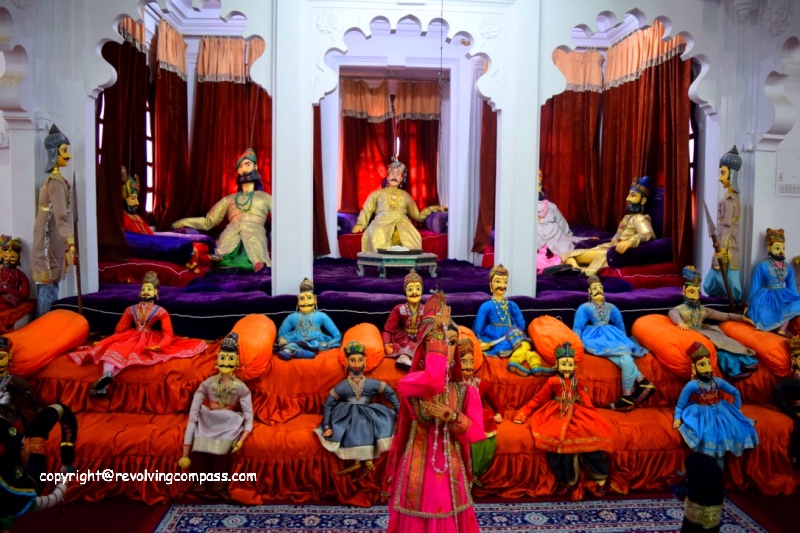
Then there are horses, elephants, and many other beautiful puppet dolls of all shape and size in the museum. At the entrance are some miniature puppets and other decor items , all handmade. You can actually buy one from here if you want. There is a caretaker sitting in one corner of the museum. Apart from that, no one else was visible. Actually, it was more like a big room filled with the colorful puppet dolls. No wonder the little one enjoyed so much. (She actually wanted to sit on that elephant and shake hand with all the other puppet dolls. 🙂 )
A tour through Bagore Ki Haveli Museum
The terrace
After making a round of the puppet museum, we took another flight of stairs. At the end of the stairs were two doors. The first door leads to an open terrace that opens towards the side facing the beautiful lake Pichola. From here, you get wonderful views across the lake, overlooking the Oberio Udaivilas Palace Hotel, Taj Hotel, City Palace and many other landmarks built right on the banks of the palace. We stood here for sometime, looking at the wonderful views.
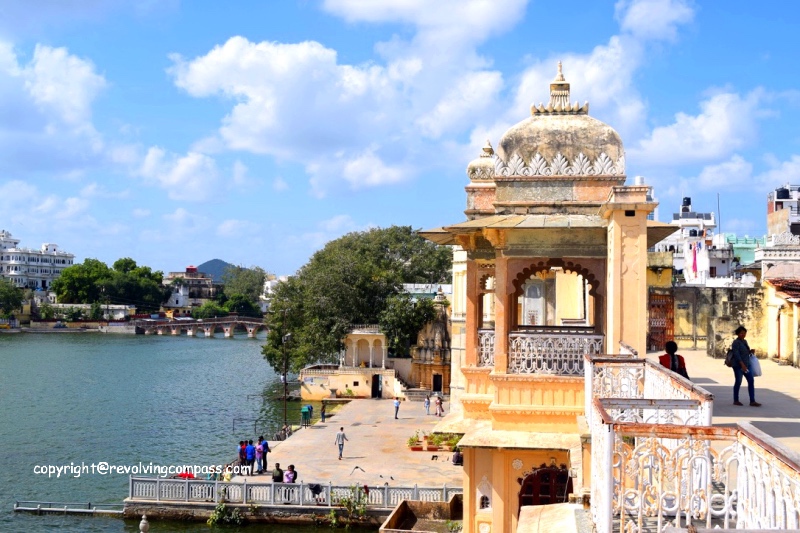
The lobby or passageway
Next, we exited the terrace and took the other door. It brought us into the second floor of the haveli. This floor of the haveli has been converted into a full fledged museum. There is an open courtyard in the ground floor of the haveli. And all the other floors of Bagore ki Haveli museum open to this courtyard. Each floor has a lobby that runs all around and then there are rooms on all corners of this lobby. Each of the room has been converted into a setup for the museum.
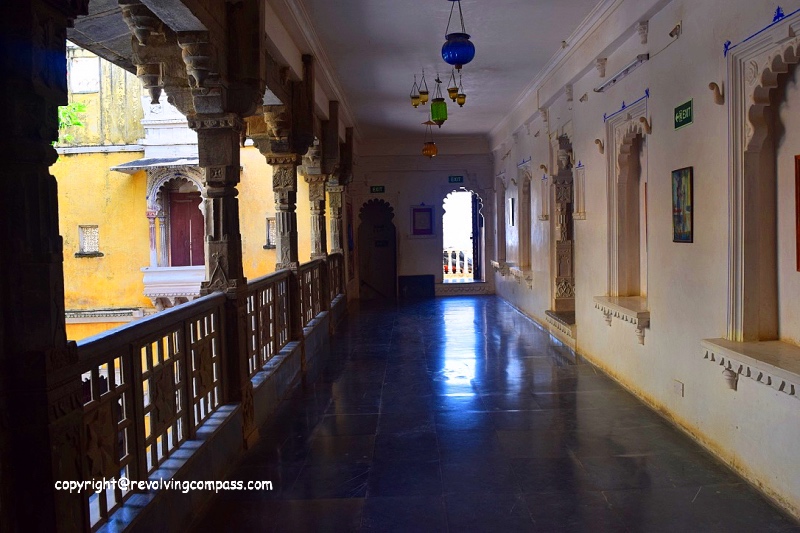
The rooms
One displays a bedroom setup from the old haveli. It has an old bed in a corner, with basic stuff that the old bedroom used to comprise of. Yet another one is setup like a living room. It has rugs on the ground, with beautiful cushions and 3-D models of people sitting around. When you look at them you get a feeling that they are going to start taking and walking any moment 🙂 Similarly, there is a kitchen setup. The kitchen consists of old earthen utensils that were used for cooking in the good old days when the haveli thrived with it’s actual inhabitants. And there are other rooms – leisure, game etc.
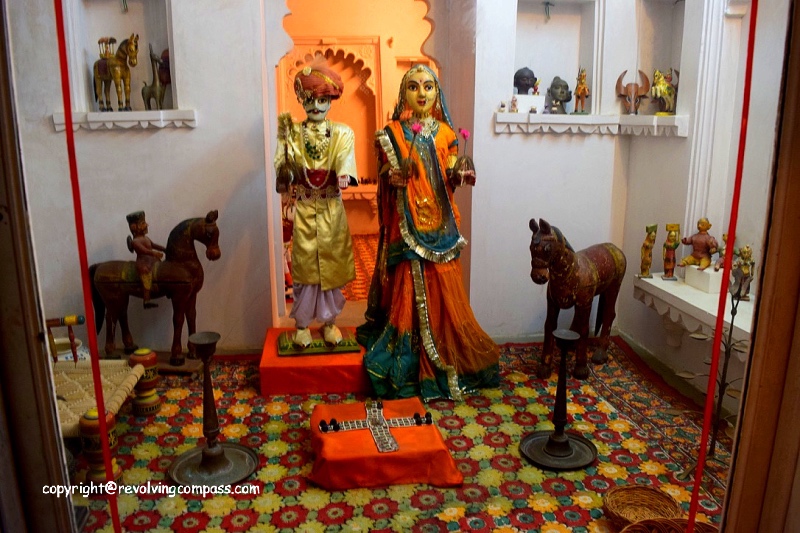
The paintings
Apart from the rooms, there are a number of beautiful paintings hung on the wall of the lobby. These paintings depict scenes from the royal era. And some also have a description of what they represent. These include paintings of women enjoying along the bank of lake Pichola or doing some household chores. Also, some depict kinds preparing to go on war. And yet others depict the family hierarchy of the residents of Bagore ki Haveli.
The beautiful swing
There is a beautiful swing hanging from the roof in the lobby. The swing is visible as you take a turn at the first left corner at end of the first lobby. Although I wondered looking at it how in the ancient times the ladies of the haveli would have enjoyed swaying here.
The Turban section at Bagore ki Haveli Museum
As we completed the tour of the first floor of Bagore Ki Haveli Museum and came down to the ground floor, we encountered another beautiful section of the museum. This sections hosts different turbans from different states of India. Turban is a piece of clothing worn on the head. And it is particularly worn in the states of Punjab, Haryana, Rajasthan and Gujarat.
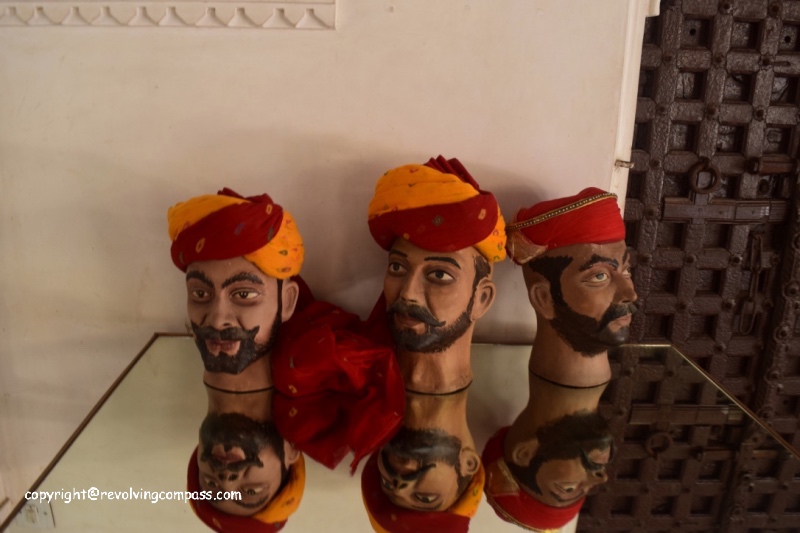
Although the style and the color and print of the turbans vary from one state to another. For example, in Punjab, you get to witness Turbans made of plain cloths in different colors. Rajasthani Turbans are made of the typical tie-dye fabric in different vibrant colors. While Gujarati Turbans are also similar to Rajasthani, but differ in the choice of colors and size. As you walk through this section, you get introduced to all these different turbans, which are an integral part of the culture in this part of India.
The weapons section at Bagore Ki Haveli Museum
After visiting the turban section, we came out of the main Haveli. And headed to the next section – the weapons section – at the other end of the courtyard. This section is actually located right besides the entrance gate. And as the name suggests, this section hosts a number of weapons on display. These are the weapons that were once upon a time used by the kings and their armies in the battle. In conclusion, it is a small section and can be covered quickly.
The wedding section at Bagore Ki Haveli Museum
As we came out of the weapons section, we thought we were done with all that was to be seen in Bagore Ki Haveli. And thus, we decided to proceed towards the exit. But then we saw on our right hand side, a board indicating an entrance to yet another section. Intrigued, we headed to this section. This is a small section again wherein using a 3-D model, the different stages of an Indian wedding are displayed. Again, it is a very cute and beautiful section. Overall, it was real joy going through it and understanding the significance of the numerous customs that mark an Indian Wedding. And also how far in history the origin of these customs goes. Which once more proves the deep routes of the Indian culture.
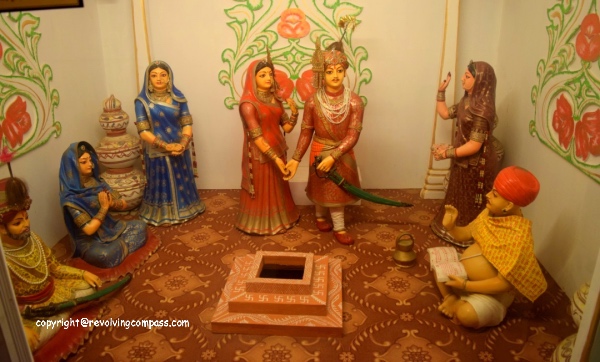
If you are interested to learn more about the different customs, and see how this beautiful section looked, you can come on a virtual tour of the wedding section at Bagore Ki Haveli Museum with us, in this post.
In conclusion, we had a wonderful time walking through he Bagore Ki Haveli Museum and exploring it’s different sections.In our opinion, it is a must visit when in Udaipur, Rajasthan.
Tips on visiting here
- Bagore Ki Haveli Museum is located in the heart of Udaipur, on the bank of lake Pichola. It is at a 5 minutes walking distance from Jagdish Temple and almost 8 minutes walking distance from Udaipur City Palace. So if you happen to visit one of these, you can easily walk off to Bagore ki Haveli museum from there.
- The place is easily reachable from other parts of Udaipur by various means of communication like hiring a cab or an autorickshaw.
- Also, it is open all days of the week from 10am to 5:30pm.
- There is an entry fee along with camera fee that can be purchased at the entrance of the museum
- There is a special Dharohar Dance show that is performed on the terrace of the museum in the evening. However, we couldn’t stay back for it since we visited in the afternoon. So, if interested, you can time your visit accordingly to catch this show. I have heard it is quiet good.
- Carry your own water and snacks. There are no food shops or outlets inside the museum.
- Also, wear comfortable shoes as there will be lots of walking to be done all through the day.
- And wear comfortable cotton cloths if visiting in the summer. There is no AC inside the museum. It is an open haveli.
- Finally, it will easily take around 1.5 to 2 hours to cover the complete museum. So, provision for your time accordingly.
PS: Some of our links are affiliated, this means we will earn a commission when you buy a service or product by clicking those links. However, this will have no extra cost for you.
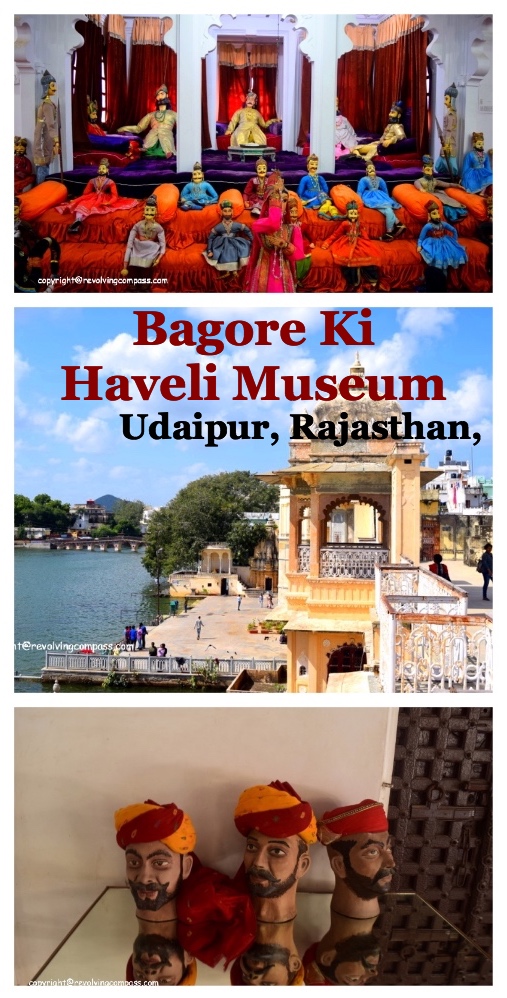
You might as well be interested in
Beautiful Wedding depiction at Bagore Ki Haveli Museum
Shilpgram: Must visit in Udaipur
A day trip to Chittorgarh fort from Udaipur
A day trip to Kumbhalgarh fort from Udaipur
The magnificent Jain Temple of Ranakpur
How best to spend 4 days in Udaipur – itinerary
An evening at Chokhi Dhani, Jaipur
The unconquored fort of Nahargarh, Jaipur
Hello, I wanted the Instagram page of Bagure Ki Hawli Museum
It’s weird not to visit this museum when in Udaipur. It is actually located in its heart so every visitor must check out the place. I love how the culture and tradition were presented in the musuem.